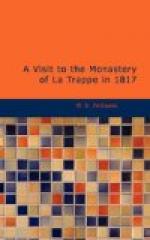The form of the Donjon is a square. The towers at the four angles are divided into five floors, each having a separate stair-case, and each floor is vaulted, with an apartment in the centre, sustained by pillars, which are chimneys. At each of the four corners of the apartment in the centre is a cell thirteen feet square. The towers are encompassed on the third story by a large gallery on the outside, and on the top of each there is a small circular terrace. Such is the strength and prodigious solidity of this building, that it is said to be capable of resisting the heaviest cannon, and is bomb proof. The hand of time appears not to have made any impression on its outward surface.
The first hall is called “La chambre de la question:” its name indicates sufficiently the horrid purposes to which it was appropriated! So late as the year 1790 were to be seen chairs formed of stone, where the unhappy victims were seated, with iron collars fixed to the wall by heavy chains, that confined them to the spot while undergoing the torture! In these prisons, deprived of air and light, were beds of timber, on which they were allowed to repose during the interval of their sufferings.
The upper floor, named “La salle du conseil,” from the Kings holding their council there, while it was a royal residence, is secured by a door of great solidity, and each prison at the angles had three doors covered with iron plates, with double locks and treble bolts. The doors were so contrived as to open crossways, each serving as a security to the other. The first acted as a bar to the second, and this to the third, so that it was necessary to close one before the other could be opened.—Such was the mode of confinement in this prison, the walls of which are sixteen feet thick, and the arches thirty feet high.
The other eight towers were also prisons. The one called “La tour de la surintendance” contains cells six feet square; the bed places are of stone. There is a square hole to descend into the vaults beneath, where, like a tomb, the miserable prisoner was immured for ever!!! Often, alas! for imaginary crimes, or for causes which make us shudder at their wantonness and barbarity, an unfortunate victim has been torn from the bosom of his family, to perish unheard of and unknown!
The French Government have, I understand, issued an order to prevent any one from entering this place from motives of curiosity; and let us hope that the humane and enlightened policy of the restored Monarch will close its cells for ever!
The following beautiful lines, with which I close an account of the most horribly interesting spot I ever visited, are from the pen of Delille:




